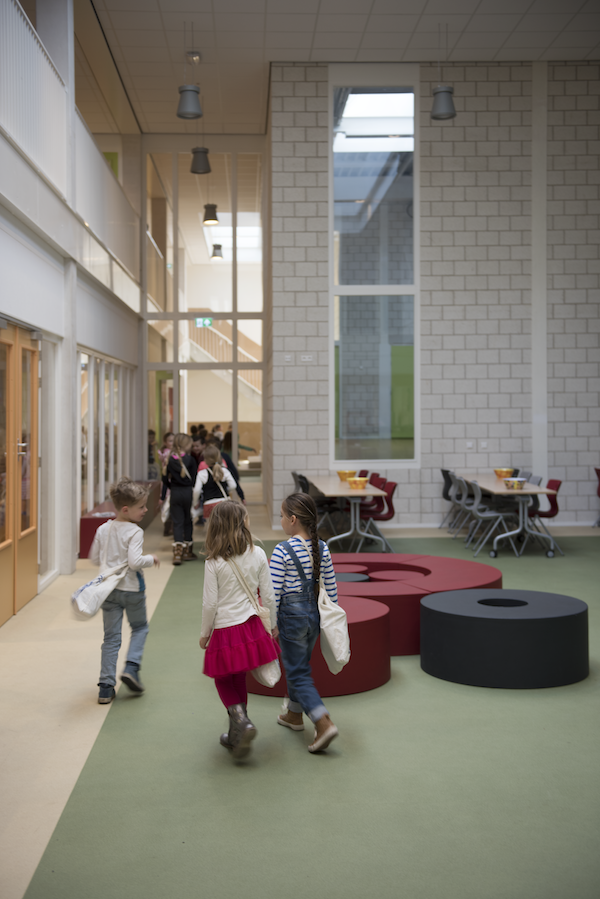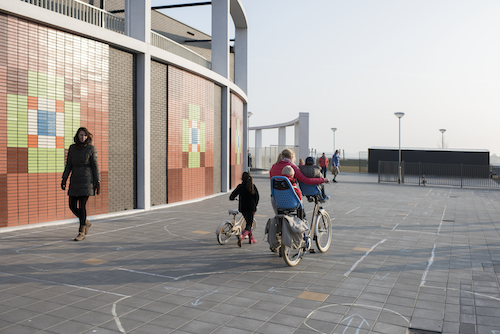Can architecture create choice architecture? The role that architecture can play seems evident: “Design-led interventions can make better choices easier or constrain behaviours by making certain actions more difficult.”2 The purpose of this article is to outline the definition(s) of health and well-being, and to determine the potential implications and opportunities for housing design.
When we discuss well-being in buildings, it is more important to incorporate a wide range of both quantitative and qualitative health considerations rather than to focus on single, narrowly defined criteria. Such ‘silo thinking’ tends not to aid good design (perfectionism can be crippling) and often different criteria are in tension. An alternative approach is to determine ‘good enough’ strategies which increase diversity and adaptability, and that are user-centred.
This is not to deny the potentially chronic health impacts of poor indoor environmental quality on certain sectors of the population (i.e. large impact for a small population), but rather to balance and complement this with strategies to improve well-being for the wider population (i.e. modest improvement for a large population).
The structure of this article is divided into two sections. The first section reviews the spatially relevant definitions of well-being and their relationships to health and the second section draws on research to define the implications and opportunities for architecture.
Defining health and well-being
The World Health Organisation now defines health not as the absence of ill-health but as “a state of complete physical, mental and social well-being.”3 The definition of health has been changing and now includes an awareness of the interrelationships between social and psychological, as well as medical, factors. The way in which an individual functions in society is seen as part of the definition of health, alongside biological and physiological symptoms. Health is no longer simply a question of access to medical treatment but it is determined by a range of factors related to the quality of our built environment.4
This wider definition of health comes at a time of increasing pressures on health services, as a result of an ageing population, increasing obesity, rising mental health problems and higher expectations.5 Thus, the narrow focus on individual symptoms and medical treatment is no longer sufficient or sustainable, and a more holistic appreciation of the spectrum of health-related considerations, including the prevention of ill-health, is timely. This approach sees “health and well-being as interdependent; it holds ‘prevention’ as important as ‘cure’, and looks for long-term solutions rather than more immediately attainable treatments.”6 Staying healthy in your home and in your community is the way to limit the increasing pressure on health services, and thus designing the home, neighbourhood and work environment to improve health and well-being is an opportunity that presents itself.
In the field of sustainable development, reference is often made to the ‘triple bottom line’ of physical, economic and social. The health and well-being triple bottom line could be summarised as health, comfort and happiness. In order to draw more direct parallels with the built environment, we can refer to Vitruvius and his tripartite model of the three elements required for a well-designed building7:
- “firmitas” or firmness (health)
- “utilitas” or commodity (comfort)
- “venustas” or delight (happiness)
Photo: Thekla Ehling
Health is referred to in this context in more conventional terms − as the absence of disease − and typically measurable in terms of symptoms such as body temperature or blood chemistry. Comfort is widely understood to be a “condition of mind which expresses satisfaction” with the environment8 – whether thermal, visual, acoustic, etc. – and thus incorporates both qualitative psychological considerations (e.g. expectation, control) and quantitative physical parameters (e.g. temperature, air movement).
Happiness colloquially refers to emotions experienced, potentially ranging from contentment to joy. Happiness is, therefore, primarily a subjective and qualitative consideration. Despite this, research over the last decade has begun to define well-being, which will be addressed in more detail in this paper.
One key challenge is the quantification of health and well-being, and thus the assessment of the overall health performance of design. At one end of the spectrum, physical ill health is typically identifiable and measurable in terms of the symptoms and causes. For example, air quality (e.g. VOCs, PM or CO2 ) and its impact, particularly on vulnerable occupants (e.g. those with lung conditions, the young and the old), can be quantified, and even treatments of both the occupants and the buildings can be prescribed (e.g. improved ventilation, the removal of offending materials, design interventions to prevent mould growth, etc.).
Although subjective assessment of air quality, particularly related to odour, can offer useful insights, often health-threatening indicators can only be measured. Specific criteria and design strategies to tackle chronic physiological health problems can be defined, and there is a wealth of expertise to support this.9
At the other end of the health and well-being spectrum is mental well-being or happiness. As we move from the deterministic - medical to the subjective - psychological end, the common perception is that the emphasis changes from quantitative to qualitative. However, it is now evident that even within the sphere of the subjective parameters, there are emerging methodologies and indicators that can be defined.
For example, in the field of thermal comfort, there has seen a development from narrow and precise physiological comfort theory, based on the seminal work of Fanger10, to a more holistic understanding that has led to the adoption of adaptive comfort theory11. Similarly, health research has extended from the treatment of symptoms to incorporate a wider and more holistic appreciation of the well-being of the population. It is the topic of well-being that is the primary focus of this essay.
The notion of well-being consists of two key elements: feeling good and functioning well. Feelings of happiness, curiosity and engagement are characteristic of someone with a positive sense of themselves. Having positive relationships, control over your own life and a sense of purpose are all attributes of functioning well. International evidence has recently been gathered to measure well-being, demonstrating that this field has now emerged as a rigorous discipline.12
Recent research has demonstrated connections of key physical design characteristics with the Five Ways to Well-Being (Connect, Keep Active, Take Notice, Keep Learning and Give), which have been associated with positive mental health.13 Based on these findings, the following paragraphs reveal how the provision of local urban and domestic resources can impinge on the five healthy behaviours. This supports current theory and research, which shows that a sufficient quantity and quality of diverse environmental, social and physical resources can influence human cognition, which, in turn, can increase the healthy behaviours of the wider population.
Photo: Thekla Ehling
Design and well-being
The relationship between architecture and health has historically received little attention, beyond the design requirements of healthy buildings. Recent work has changed this and has established a more holistic awareness of the role of architecture in health. An example of this in the UK includes the publication of reports by the Royal Institute of British Architects14 and the Commission for Architecture and the Built Environment.15
This is supported by an increasing wealth of medical research related to physical health16 and mental health.17 The emphasis has been on ill health as a result of the effects of environmental characteristics such as overcrowding, noise, air quality and light. These effects are typically described as direct (i.e. consequences on physical and mental health) as well as indirect (e.g. through social mechanisms).18 However, rather than focusing on ill health, the definition and study of well-being has been emphasising the behaviours that support a ‘flourishing ’ population. It is the built-environment characteristics that support such positive behaviour, which is a key point of discussion here.
The science of well-being is a relatively recent area of enquiry. However, the UK Government’s ‘Foresight’ project, related to well-being19, provides the critical mass of evidence that led to the definition of the Five Ways to Well-Being mentioned above20. These represent the key behaviours that have been shown to relate to improved well-being. Each behaviour is associated with subjective well-being as reported in research papers, notably in medical journals, that draw on large-scale and meta-analysis of exacting studies. Thus there is no shortage of evidence to support the assertion that such behaviours, the Five Ways, result in improved well-being.
- Connect: the quantity and quality of social connections (e.g. talking and listening to family or strangers) correlates with reported well-being as well as physical health.21
- Keep active: there is ample evidence from global and meta-studies to demonstrate that physical activity reduces symptoms of mental and physical ill-health.22
- Take notice: being mindful – paying attention to the present and being aware of thoughts and feelings – is a behaviour that reduces symptoms of stress, anxiety and depression.23
- Keep learning: aspirations are shaped in early life, and those who have higher aspirations tend to have better outcomes. Such aspirations are modified by the environment.24 The evidence shows that also later in life, those participating in music, arts and evening classes, for example, attain higher subjective well-being.25
- Give: evidence has emerged that pro-social rather than self-centred behaviour has a positive impact on happiness. Such consequences of altruistic behaviour are related both to spending on others as opposed to oneself 26 and through volunteering and offering help.27
The critical next question is to discuss how the Five Ways to Well-Being relate to and are influenced by the built environment.
Connect
The provision of local ‘everyday public spaces’ creates opportunities for people to connect, and is a significant resource of well- being for individuals and the wider community.28Although not all users have the same requirements and expectations of a social space, key qualities include: location – accessible and proximity to other communal resources (school, market) to support casual encounters; places – to stop and sit, on a park bench or at a café table, so that encounters can be more than fleeting; adaptability – spaces without specific or prescribed functions that enable spontaneous, impromptu activities; homeliness – a sense of safety and familiarity; pleasantness – clean and peaceful, or bustling and lively; specialness – unique qualities, aesthetics, or subjective memories.
When a space is pedestrian-oriented, as opposed to car-oriented, this is correlated with a sense of community, due to the perception of the pedestrian environment being strongly related to opportunities for social interaction.29 And finally, natural, green or landscape qualities have been widely, and for a long time, associated with a range of health benefits.30 In summary, “public spaces that brought people together and where friendships and support networks were made and maintained were key to a general sense of well-being.” 31
Keep active
Physical activity (walking, cycling, sports, etc.) is widely associated with reducing causes of chronic conditions and the burden of disease, disability and premature death. Design characteristics associated with increasing activity include access to physical activity facilities (e.g. sports centres and equipment), convenient and proximate access to destinations (work, shops, school, public transport), high residential density (which is associated with greater proximity to facilities and destinations), land use (e.g. mixed use) and walkability (convenient and safe pavements, traffic calming features).32
Although there are some potential additional benefits to physical activity in an outdoor and preferably natural environment, exercise indoors can be equally effective.33 Design strategies to promote indoor physical activity include: the provision of (shared) exercise space, encouraging stair use through the distribution (separation) of functions over different floor levels, and creating attractive experiences along circulation routes (views, art, daylight, greenery).
Take notice
Being mindful and taking notice of a design intervention in a population is a behaviour for which there is only recent evidence. However, in a randomised control test, the provision of art, planting and landscaping, wildlife features (e.g. insect boxes), and seating are examples of the kind of interventions that resulted in significantly increased observations of people stopping to take notice.34
The same study also showed that diverse types of open space (combining green as well as hard landscaping) and a higher relative proportion of public to private space is also associated with increased reported mindfulness.
Keep learning
There is evidence from educational research that the physical environment of the home and classroom are mediating variables that influence intellectual development. Domestic parameters include a home that is clean and uncluttered, appears safe for play and is not dark or monotonous.35 The distance and orientation of seating in relation to others will influence the level of interaction and dialogue. For example, in a circle of seats, people facing each other will converse more than
people adjacent to each other. Unobstructed eye contact is an important variable particularly in an educational context, making a semicircle classroom seating arrangement most effective.36 At a more prosaic level, in order to support learning, interior environments need to be physically and thermally comfortable, safe, well lit, quiet and have clean air.
However, there is evidence that learning will improve when comparing a poor environment (a run-down and poorly maintained space) with an adequate one (one that is ‘good enough’), but that further and more extravagant facilities (specialised spaces or digital equipment) do not show further improvements in learning.37As previously mentioned, the opportunity to engage in art, music and evening classes increases well-being and thus such activities should be accommodated in the design of homes (light, cleanable spaces for art, soundproof spaces for music) and neighbourhoods (local communal spaces for classes).
Give
The presence of environmental stressors reduces helping behaviour, but little further explicit evidence is available beyond that which has been discussed above, which relates the physical environment with neighbourhood social capital.38 There is evidence that people are less altruistic in urban than in rural environments, which, if nothing else, confirms that the integration of green space and contact with nature can be valuable.39
Although it is difficult to observe altruism and its explicit relationship to design parameters, it can be shown that self-reported altruistic behaviour is more prevalent in neighbourhoods that incorporate the positive environmental and physical characteristics of space design (diversity, proximity, accessibility and quality) that have already been mentioned.40

.svg)





